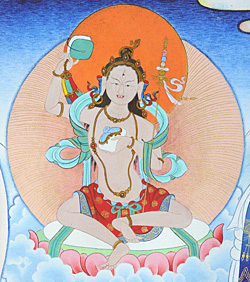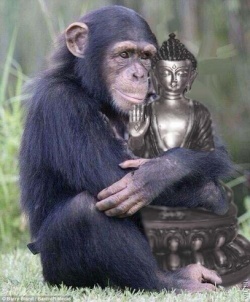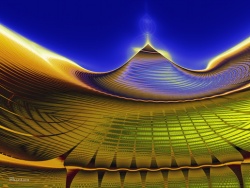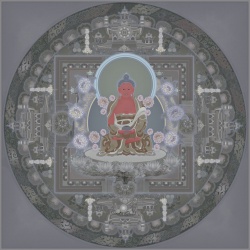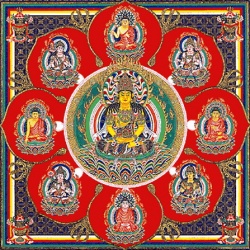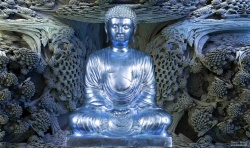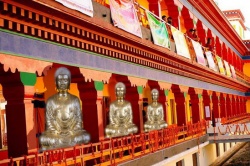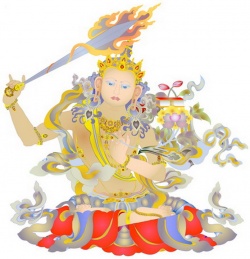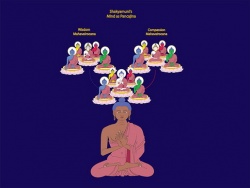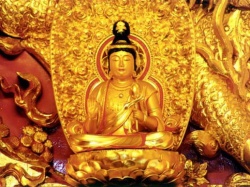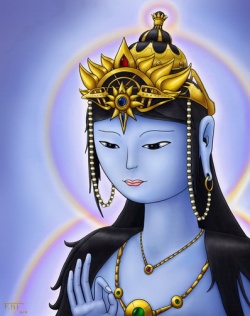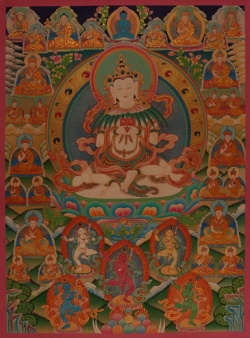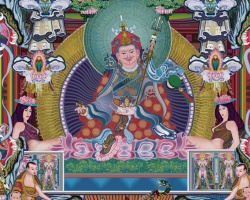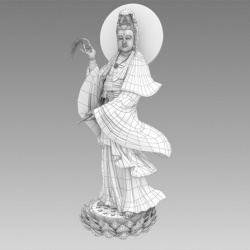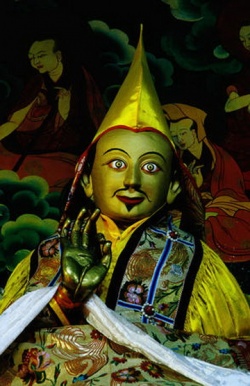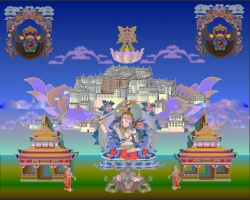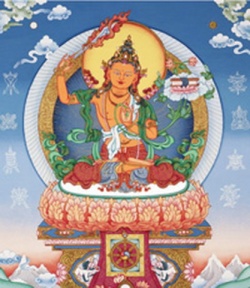Tian-tai Metaphysics vs. Hua-yan Metaphysics
By JeeLoo Liu
Tian-tai Metaphysics vs. Hua-yan Metaphysics
Introduction Tian-tai Buddhism and Hua-yan Buddhism can be viewed as the two most philosophically important schools in Chinese Buddhism. The Tian-tai school was founded by Zhi-yi (Chih-i) (538-597 A.D.). The major Buddhist text endorsed by this school is the Lotus Sutra, short for ¡§the Sutra of the Lotus Blossom of the Subtle Dharma.¡¨ Hua-yan Buddhism derived its name from the Hua-yan Sutra, translated as The Flower Ornament Scripture¡¨ or as ¡§The Flowery Splendor Scripture.¡¨1 The founder of the Hua-yan school was a Chinese monk named Du-shun (557-640 A.D.). The second patriarch of Hua-yan is Zhi-yan (602-668 A.D.), who studied with Du-shun. However, it is generally acknowledged that the real founder of Hua-yan Buddhism is its third patriarch, Fa-zang (643-712 A.D.). He introduced the division of ¡§the Realm of Principle¡¨ and ¡§the Realm of Things,¡¨2 which was developed by Hua-yan¡¦s fourth patriarch Cheng-guan (738-839? A.D.) into the defining thesis for Hua-yan Buddhism ¡V the four dharma realms¡¨: the Realm of Principle, the Realm of Things,3 the Realm of the Noninterference between Principle and Things, and the Realm of the Noninterference of All Things.
In this paper, I shall give a comprehensive explanation of the metaphysical views presented by both Tian-tai and Hua-yan schools. In some respects the two schools have similar tenets and similar terminology, but ultimately their metaphysical views are quite contrary to each other. In this paper I shall argue that Tian-tai¡¦s metaphysics is compatible with commonsense realism, while Hua-yan¡¦s metaphysics is closer to a form of subjective idealism which directly opposes commonsense realism. I. Tian-tai¡¦s Notion of the Reality The most distinctive trait of the Tian-tai world view is that there is only one reality, which is both the phenomenal world and nirvana. Zhi-yi tries to explains away the apparent incompatibility between this view and the ¡§two-world view¡¨ that marks primitive Buddhism. He formulated many famous phrases and slogans of the Tian-tai philosophy, such as Ten Dharma Realms,¡¨ ¡Ten Suchnesses,¡¨ ¡Ten Realms mutually contained,¡¨ and ¡§One thought contains three thousand worlds.¡¨ Even though Tian-tai Buddhism is based on the Lotus Sutra, all these descriptions are not found in the Lotus Sutra itself. They can be seen as the core theses of Tian-tai philosophy. We shall explain each of them in the following.
Ten Dharma Realms and Oneness of Reality
When primitive Buddhism divides up the phenomenal world and nirvana, the two realms of existence are mutually exclusive. The phenomenal world is marked by the cycle of transmigration. Nirvana is the cessation of transmigration. What primitive Buddhism means by the ¡§phenomenal world¡¨ is not just the physical world that we sentient beings experience. It includes six realms of existence (called ¡§six destinies¡¨ or ¡§six dharma realms¡¨) that range from hell to gods, with beasts and men as the middle realms.4 Therefore, what we call the spiritual realm or the afterlife, such as hell and heaven, is also included in the phenomenal world. One¡¦s existence is not defined as from birth to death of an individual being; rather, it is a continuous cycle of life and death. To reach nirvana is to be completely free of this recycling of life and death, to exit the whole phenomenal world. In primitive Buddhism, nirvana is the ultimate reality. The phenomenal world is not real. A simple graph can illustrate the polarity of the two worlds conceived in primitive Buddhism:
Cycle of Life and Death: 1. hell beings 2. hungry ghosts 3. beasts or beings of animal nature 4. Asuras (demons) 5. human beings 6. gods or heavenly creatures
Nirvana A revolutionary thesis of the Tian-tai school, on the other hand, is to claim that the phenomenal world is nirvana and nirvana is the phenomenal world. There is only one reality, not two. As Zhi-yi puts it, ¡§A single, unalloyed reality is all there is ¡V no entities whatever exist outside of it.¡¨ (The Great Calming and Contemplation, 114) His student
Guan-ding also explains the world view of Tian-tai in this way: ¡§There is no duality, no difference between them; the phenomenal, as it stands, is the real.¡¨ (ibid., 127) This one reality is divided into ten dharma realms, with four more additions to the six dharma realms of primitive Buddhism:
1. hell beings „³ Cycle of Life and Death 2. hungry ghosts „³ Cycle of Life and Death 3. beasts or beings of animal nature „³ Cycle of Life and Death 4. Asuras (demons) „³ Cycle of Life and Death 5. human beings „³ Cycle of Life and Death 6. gods or heavenly creatures „³ Cycle of Life and Death 7. Shravakas (Voice-hearers¡¨) „³ Nirvana 8. Pratyekabuddhas (¡§Self-enlightened Ones¡¨) „³ Nirvana 9. Bodhisattvas „ Cycle of Life and Death/Nirvana 10. Buddha „³ Nirvana
The first four realms are called the evil path.¡¨ They represent the lowest and the most painful states of existence. Human beings and gods are placed in the same category, in that both existences are mortal and are mixtures of happiness and misery. The four new realms are called ¡§the holy path.¡¨ They include the highest form of attainment for the Hinayana school: arahats, which are divided into Voice-hearers and Self-enlightened Ones. ¡§Voice-hearers¡¨ refers to those who listened to the Buddha¡¦s early teachings and followed the doctrines of primitive Buddhism.
Self-enlightened Ones¡¨ refers to those who gained understanding on their own. Both forms of arahats have accomplished the goal of extinction and they regard nirvana as the negation of the phenomenal world. They are not interested in helping others reach the same goal. At the next level we have the highest form of attainment for the Mahayana school: bodhisattvas. Bodhisattvas also regard nirvana as the ultimate goal of attainment; however, they choose not to enter nirvana out of their compassion for all sentient beings who have not entered nirvana. Finally, the utmost highest form of existence is called Buddha. According to the Lotus Sutra, Buddhas can enter nirvana and reenter the phenomenal world as they wish. Tian-tai¡¦s teaching is that everyone should aim to become a Buddha. According to Zhi-yi, ¡§All reality is included within these ten dharmas.¡¨
(The Esoteric Meaning, 181) There is nothing that exists outside the ten dharma realms. These ten realms are distinguished because of their different causes and conditions, but they are not sharply divided as separate realms. One notable tenet of the Tian-tai school is that ¡§the ten dharma realms are mutually contained.¡¨ The mutual containedness of the ten dharma realms is difficult to understand, however. The most direct analysis is to say that in each of the ten dharma realms, there is a further distinction into ten sub-dharma realms. Another analysis is to say that each of the ten dharma realms contains the potentials¡¨ for all ten realms, but it only ¡§manifests¡¨ the one that characterizes itself.5
A third interpretation is to say that each single realm is at the same time the totality of ten dharma realms, all is one and one is all. I think this last interpretation is the one most consistent with Zhi-yi one reality¡¨ theory. In other words, I think that when Zhi-yi divides up the world into ten dharma realms, he does not think that these ten realms exist apart from one another. The nirvana in which Buddhas reside is the same world as the hell in which hell beings reside; it is also the same world as the physical world in which present sentient beings inhabit. As Zhi-yi says, ¡§All of reality is included in hell and does not transcend this destiny¡K. The same is true for all destinies up to and including the Buddha realm.¡¨ (The Esoteric Meaning, 182) These ten dharma realms are mutually contained since they are all part of the whole world, and there are no boundaries that set them apart.
In both primitive Buddhism¡¦s picture of six dharma realms and Tian-tai Buddhism¡¦s picture of ten dharma realms, we see that the common world view can be regarded as ¡§anti-physicalism.¡¨ The physical world is not the only reality ¡V it is merely part of the whole reality we experience through our various forms of existence. The identity we establish since birth is also not our true identity ¡V it is rather a state in the whole process of life cycles. In this sense the ¡§experiential world¡¨ is not just what we experience after we are born. It is the totality of our experiences as hell beings, as beasts, as human beings, as gods, and for the Tian-tai school, it even includes our experiences as arahats, bodhisattvas, or even as Buddhas.
The fundamental difference between traditional Indian Buddhism and Tian-tai Buddhism (as well as other major schools of Chinese Buddhism), is that in the former, the ultimate goal is to exit this world and enter a totally different realm of existence, while in the latter, there is no this-world/other-world distinction. Contrary to primitive Buddhism¡¦s setting the ultimate goal as terminating the cycle of life and death, the Lotus Sutra says, There is no ebb or flow of birth and death, and there is no existing in this world and later entering extinction.¡¨ (Chapter 16, Watson 2002, 102) When the four realms of the ¡§noble path¡¨ are included into the same world as the cycle of life and death, one no longer needs to deny one¡¦s present experiences, negate one¡¦s present emotions, and renounce one¡¦s present life, so as to reach nirvana. As Zhi-yi says, ¡§since cyclic birth and death itself is identical with emptiness, how could it ever be discarded? Since nirvana itself is identical with emptiness, how could it ever be attained?¡¨ (The Great Calming and Contemplation, 188)
Zhi-yi says, ¡§One thought contains the ten dharma realms. Each dharma realm also contains the ten dharma realms, [so there are] one hundred dharma realms. Each dharma realm contains thirty worlds, so one hundred dharma realms contain three thousand worlds. These three thousand worlds are contained in one thought.¡¨ (Swanson 1989, 13) This is the famous Tian-tai thesis: ¡§one thought contains three thousand worlds.,¡¨ or as Hurvitz translates it, ¡§the Trishiliocosm in a moment of consciousness.¡¨ (Hurvitz 1962, What does the word ¡§contain¡¨ mean in this context? How can one thought contain all of reality? We can say that there are at least three plausible interpretations: (i) contain as ¡§capable of producing¡¨ ¡V in this way the claim is close to idealism which treats the world as a mere figment of the mind¡¦s imagination
(ii) contain as capable of perceiving¡¨ ¡V in this way the claim is still compatible with commonsense realism and places more emphasis on the function of sense organs (iii) contain as capable of conceiving¡¨ ¡V in this way the claim is at least not incompatible with realism and stresses more the mind¡¦s cognitive function Sometimes Zhi-yi s remark inclines us to take the first interpretation. He says, There are no distinct dharmas in the three realms; all are but the product of one single mind. Mind is like a skilled painter, producing all sorts of forms. It constructs the six destinies, introducing innumerable distinctions in appearance and value [among them].¡¨ (The Great Calming and Contemplation, 189-90) If contain¡¨ really means ¡§produce,¡¨ then the world as the product of the mind¡¦s creation becomes illusory and unreal. This interpretation would make Tian-tai¡¦s world view close to idealism. However, Zhi-yi is not an idealist.
To liken Tian-tai¡¦s claim that one thought contains three thousand worlds¡¨ to the Consciousness-only school¡¦s claim that ¡§Alaya is the storehouse for all seeds of worldly phenomena,¡¨ is to greatly misconstrue Tian-tai¡¦s world view. Zhi-yi does not claim that the only thing real is Mind and that the world is dependent on Mind¡¦s activities. The world is not a by-product of the Buddha¡¦s mind, or of any mind whatsoever. As Zhi-yi puts it, The objects of the [true] aspects of reality are not something produced by Buddhas, gods, or men. They exist inherently on their own and have no beginning.¡¨ (The Esoteric Meaning, 210) From this quote we can see that Tian-tai philosophy is fundamentally a realist philosophy.
Its world is an objective world, not a creation of the Buddha or the Mind. ¡§One thought contains three thousand worlds,¡¨ but this one thought is not therefore the substance of the three thousand worlds. To Zhi-yi, the world is as real as the mind is, and the mind is as empty as the world is. He explains, ¡§In what way is [this thought] identical with emptiness? Because [all factors of its arising] come into being through conditions: whatever originates conditionally lacks subjective own-being, and to lack own-being is to be empty.¡¨ (The Great Calming and Contemplation, 194) The mind is not substantially existing, since it relies on the world to generate its cognitive content. At the same time, the world relies on the mind¡¦s cognition to contain all dharmas. According to Zhi-yi, neither the mind nor dharmas have the power to arise spontaneously on their own. Since each one is the conditions for the other¡¦s arising, each one depends on the other for its existence.
When they are separate they do not arise at all.¡¨ (The Esoteric Meaning, 198) Because of their ontological interdependence, the mind and the world are logically co-existent ¡V one is not prior to the other. As Zhi-yi puts it, ¡§We do not say that the mind exists first and dharmas come to be later; we also do not say that dharmas exist first while the mind come to be later.¡¨ (The Great Calming and Contemplation, Vol. 5, my translation) Under this mind-world relationship, we see how the first interpretation is not acceptable. Of the two remaining interpretations of ¡§contain,¡¨ ¡§capable o conceiving¡¨ gives a reading that has a broader scope than ¡§capable of perceiving¡¨ does. If ¡§perception¡¨ is taken to refer to the function of sense organs, then it is questionable whether the mind is really capable of perceiving the totality of reality (the three thousand worlds). To say that the mind is capable of conceiving the totality of reality, on the other hand, poses no difficulty. The minds of sentient beings conceive all dharmas to be objects of craving and attachment, or resentment and rejection. These sentient beings are thus caught in the cycle of life and death and can never be totally free of suffering.
The minds of Voice-hearers, Self-enlightened Ones and Bodhisattvas conceive all dharmas to be provisionally existent and empty in self-nature. These beings are therefore separating the phenomenal world and nirvana as two distinct realms. Finally, the minds of Buddhas conceive all dharmas to realize their true dharma nature ¡V all are provisionally existent, empty and manifesting the Middle Way. They can therefore recognize that all dharmas and dharma realms are in one unified reality. Therefore, the creation of ten dharma realms depend on sentient beings¡¦ mental power. One¡¦s single thought could bring one down to the realm of hell; one¡¦s single thought could also elevate one to the realm of Buddhas. As Zhi-yi elaborates his painter analogy, he says, ¡§By going back and overturning this [deluded] mind, one produces understanding ¡V just as the painter first washes away the previous forms, applies white plaster, [and is then able to] paint anew.¡¨ (The Great Calming and Contemplation, 190) We can see that it is the same canvas, the same world; what changes is simply how we paint, or conceive, it. It is in this sense that we should understand the connection between Mind and the world. The True Nature of Things (Dharmas): the Threefold Truth Zhi-yi¡¦s idea of the Threefold Truth is derived from Nagarjuna¡¦s statement: ¡§Whatever dharma arises through causes and conditions, that I declare to be identical to emptiness. It is also a provisional designation. This, furthermore, is the meaning of the Middle Way.¡¨ (Guan-ding¡¦s Introduction to The Great Calming and Contemplation, 107) However, Nagarjuna himself advocates the Two Truths theory: one is the supreme truth, the other is the mundane truth. The mundane truth takes all dharmas in the phenomenal world to be dependently existent, while the supreme truth illuminates their empty nature.
On the level of the mundane world, we can say that things exist; on the level of the ultimate reality, however, we must say that things are all empty in nature. Therefore, the supreme truth is ¡§more true¡¨ than the mundane truth. There are two levels of truth, and the second level ultimately denies the first one. Zhi-yi¡¦s Threefold Truth is greatly different from Nagarjuna¡¦s Two Truth in spirit. Zhi-yi himself does not take the credit for being the initiator of the notion of Threefold Truth. He does not think that it is a novel idea specific to the Tian-tai teaching either. He says, ¡§Many Sutras contain the meaning [of the threefold truth] in detail, but the terms come from the [Ying Luo Jing] and the [Ren Wang Jing].¡¨ (The Esoteric Meaning, 252) However, we must recognize that the Threefold Truth under his interpretation renders the Buddhist¡¦s perspective of the world totally anew.
The Threefold Truth includes
(i) the truth of provisional existence6 (ii) the truth of emptiness (iii) the truth of the Middle Way
The truth of provisional existence states that all dharmas¡¦ existence depend on many other causal factors, without which they would not have existed. Therefore, dharmas exist, but they exist provisionally, temporally, dependently. The emphasis of this truth is on existence, and thus it represents the acknowledgement of this phenomenal world. Secondly, the term ¡§empty¡¨ in Tian-tai¡¦s usage does not mean void or nothingness, but ¡§empty of substance.¡¨ The truth of emptiness states that all dharmas are empty in the sense that they do not have self-nature or substance. Finally, the term ¡§middle¡¨ in this context does not mean the mid-point of two poles, but the avoidance or the transcendence of extremes.
To transcend the insistence on existence (the School of Being) as well as the insistence on emptiness (the School of Emptiness) is the Middle. Leon Hurvitz explains it as ¡§the complete lack of contradiction¡¨ between the two extremes. (Hurvitz 1962, 274) Zhi-yi says, ¡§The reality of non-duality is called the Middle.¡¨ (Swanson 1989, 153) ¡§The Middle¡¨ and ¡§the Real¡¨ are thus interchangeable in his usage. The word ¡§way¡¨ is translated from the Chinese word ¡§dao,¡¨ which stands for the highest principle of the universe. Therefore, ¡§the Middle Way¡¨ is simply another name for the ultimate reality or the highest principle of the universe itself. The truth of the Middle Way states that Reality itself is simply thus: all dharmas are both provisionally existent and empty.7
From these three truths, we can see the true nature of all dharmas and of Reality itself. There is no other realm outside of the provisionally existent phenomenal world. The world manifesting emptiness (Nirvana) is simply the provisionally existent phenomenal world. Since this world has both provisional existence and emptiness, it is the world of the Middle Way. With the introduction of the Middle Way, Zhi-yi eliminates the polarity between the phenomenal world and nirvana. The Threefold Truth describes the one unified Reality (called ¡§the Middle Way¡¨), which is the phenomenal world and nirvana at the same time. The three Truths can be seen as the three aspects of the same reality. As Zhi-yi puts it, ¡§Though these [three aspects of reality] are an integrated unity, they are called threefold; though they are threefold, they are called a unity. (The Esoteric Meaning, 176) Zhi-yi thinks that ten dharma realms themselves also manifest the threefold truth.
Even though reality is conventionally divided into ten realms, the division should not be seen as absolute. All ten dharma realms are at the same time empty, provisionally existing and manifesting the Middle Way. Following his teacher Hui-si, Zhi-yi calls this integration of the three aspects of ten dharma realms simply as ¡§suchness¡¨ or ¡§such-like characteristics.¡¨ He says that the ten dharma realms have ¡§Ten Suchnesses¡¨:8 such-like appearance, such-like nature, such-like essence, such-like power, such-like function, such-like causes, such-like conditions, such-like results, such-like retributions, and such14 like ultimate identity of beginning and end. Without going into details about what each of the suchnesses means, we can say that ¡§Ten Suchnesses¡¨ simply means that what we want to investigate as the ultimate reality, is simply as such ¡V as what we see around us in the phenomenal world. The Consciousness-only distinguishes True Thusness¡¨ from the phenomenal world transformed by consciousness; the Tian-tai school simply calls this phenomenal world¡¦s suchness the True Thusness.¡¨ There is no need to find a reality beyond this reality ¡V there is no other reality in this world view.
In summary, from Tian-tai¡¦s identifying the ultimate reality with the phenomenal world, we see that it does not posit a ¡§noumenon¡¨ or substance beyond the phenomenal world. The world as we know it is the only world there is. Zhi-yi says, ¡§To keep away from the mundane dharmas and yet seek the ultimate Truth [elsewhere] is similar to avoiding this Emptiness and seeking Emptiness elsewhere. The mundane dharmas are themselves the ultimate Dharma [i.e., the Truth]. There is no need to forsake the mundane and adhere to the sacred.¡¨ (The Great Calming and Contemplation, quoted by Ng, 166) This view does not deny commonsense realism¡Xwhat we perceive around us is real. It is thus not a form of idealism.
II. Hua-yan Metaphysics: Subjective Idealism The Flower Ornament Scripture denies that the phenomenal world really exists. The phenomenal world means the world we, as human beings, presently experience. In the Flower Ornament Scripture, this world is likened to dream, illusion, phantom, echo, the magician¡¦s conjuring, and the reflection in the mirror. (Chapter 29, 880-86) Everything we perceive around us, this worldly phenomena, is also like a reflection or an illusion. As reflections, objects ¡§have no location¡¨ and ¡§no substantial nature.¡¨ (Chapter 2, 175) As illusions, objects do not have a real beginning or end, nor do they have a definite origin or a final exit. In one synopsis, the Scripture says that all things ¡§have no true reality.¡¨ (Chapter 5, 248)
Another way to say that all things do not have true reality is to say that they are ¡§empty.¡¨ Calling mundane objects ¡§empty¡¨ is a common tenet of all Buddhist schools, but different schools give the term different interpretations. We can encapsulate the following connotations for ¡§emptiness¡¨:
(1) ¡§Emptiness1¡¨ = being devoid of inherent self-nature and of independent existence. (2) ¡§Emptiness2¡¨ = being unreal; being illusory; being non-existent. (3) ¡§Emptiness3¡¨ = being devoid of any phenomenal characteristics and perceptual qualities. (4) ¡§Emptiness4¡¨ = void; nothingness; nil.9
In Tian-tai Buddhism, we see that phenomenal objects are empty in the sense of emptiness1, but not in the sense of emptiness2. In Hua-yan Buddhism, on the other hand, the whole phenomenal world is empty both in the sense of emptiness1 and in the sense of emptiness2. In the Flower Ornament Scripture, we see a consistent usage of ¡§empty¡¨ in conjunction with ¡§null¡¨ or to stand for ¡§having no real existence.¡¨ As the Scripture says, ¡§The nature of things is fundamentally empty and null¡K. Things have no true reality.¡¨ (Chapter 14, 375) The reason why Hua-yan Buddhists understand ¡§emptiness¡¨ in the sense of emptiness2, is that they make the following identifications: (i) Being empty = being born from conditions (being dependent on other factors for origination) (ii) being born from conditions (being dependent on other factors for origination) = having no inherent nature
(iii) having no inherent nature = non-existent
(iv) non-existent = unreal (cf. Cheng-guan, ¡§Mirror of the Mysteries of the Universe of the Hua-yan,¡¨ Cleary 1983, 105) But for the Tian-tai school, (iii) is not true. Tian-tai Buddhists do not define ¡§existence¡¨ as ¡§self-sufficient existence¡¨ or ¡§perpetual existence.¡¨ Thus the two schools can agree on their definition of ¡§emptiness¡¨ and on their view of the nature of things, and yet come to different assessments on the realness of things.
When ¡§Emptiness¡¨ (Sunyata) is used as a synonym for the ultimate reality, noumenon, it also has different connotations. Tian-tai Buddhism assigns only emptiness3 to noumenon, since noumenon is beyond our perception as well as our conception. But it denies that noumenon itself is a void with nothing inside. Hua-yan Buddhism, on the other hand, seems to assign both emptiness3 and emptiness4 to noumenon. As the Scripture says, ¡§All in the worlds is void.¡¨ (Chapter 14, 382) It also frequently uses space to be a metaphor for noumenon. If phenomena are likened to what are enclosed in space while noumenon is likened to space itself, then this notion of noumenon does seem to connote the void and the nil.
The Scripture says, ¡§Living beings and lands, all things there are in all times, in the same way, without exception, are all illusory. Making illusory forms of men and women, elephants, horses, cattle, and sheep, houses, ponds, springs, and such, gardens, groves, flowers and fruits, illusory things have no awareness and also have no abode. Ultimately of the character of nullity, they only appear according to imagination.¡¨ (Chapter 29, 880) According to this remark, worldly phenomena are formed because of the mind¡¦s imagination. If the phenomenal world is like the magician¡¦s conjuring or the artist¡¦s painting, then the magician or the painter is simply the mind itself. ¡§Mind is like an artist, able to paint the worlds.
The five clusters all are born thence. There is nothing it doesn¡¦t make.¡¨ (Chapter 20, 452) In the respect that it regards the world as being dependent on the mind for its existence/appearance, this metaphysical view is clearly that of idealism. This idealistic theme is emphasized in all Hua-yan patriarchs¡¦ commentaries on the Scripture. For example, the second patriarch Zhi-yan says, ¡§Since there is no separate objective realm outside of mind, we say ¡¥only mind.¡¦ If it operates harmoniously, it is called nirvana; therefore the Scripture says, ¡¥Mind makes the Buddhas.¡¦ If it operates perversely, it is birth-and-death; therefore the Scripture says, ¡¥The triple world is illusory ¡V it is only made by one mind¨ (The Mysterious Gates of the Unitary Vehicle of the Hua-yan, Cleary 1983, 145) The third patriarch Fa-zang also says, [W]hatever there is in the world is only the creation of one mind; outside of mind there is not a single thing that can be apprehended¡K. It means that all discriminations come only from one¡¦s own mind. There has never been any environment outside the mind which could be an object of mind.¡¨ (¡§Cultivation of Contemplation of the Inner Meaning of the Hua-yan,¡¨ Cleary 1983, 165) Fa-zang further denies the warranty of sense perception and claims that ¡§sense data have no existence.¡¨ (ibid.) In other words, it is the mind¡¦s discerning abilities that create myriad things in the world. Reality itself does not have all these discriminations; all things we perceive are thus the mind¡¦s fabrication.
Furthermore, according to the Scripture¡¦s teaching, various minds have various mental activities that lead to various acts. Since it is the mental acts that produce the world, the worlds manufactured by different minds are thus all different. The Scripture says, ¡§Just as when seeds are different, so are the fruits they produce. Because of differences in the force of acts, living beings¡¦ lands are not the same.¡¨ (Chapter 5, 243) From the fact that there are infinitely many minds, it concludes that there are infinitely many worlds which are all different. ¡§By the individual acts of beings, these worlds are infinite in kind.¡¨ (Chapter 5, 246) This is where Hua-yan¡¦s metaphysics resembles the most to the Western subjective idealism.
With the Consciousness-only school, there are as many minds as there are sentient beings. The mind¡¦s various forms of consciousness produce the phenomenal world. In particular, the eighth consciousness, Alaya or the Storehouse Consciousness, contains the seeds for all worldly phenomena. However, even though there are various minds and variously perfumed Storehouse Consciousnesses, the Consciousness-only school asserts that a common world will be transformed out of sentient beings which are perfumed similarly. In this respect what it advocates is a form of objective idealism.
The difference between objective idealism, to which we assimilate the Consciousness-only Buddhism, and subjective idealism, with which we now compare Hua-yan Buddhism, is that for the former, there is still an objective world shared by different minds whereas for the latter, worlds are different inasmuch as minds are. Since phenomenal worlds result from various mental activities of sentient beings, there are as many phenomenal worlds as there are sentient beings. As the Scripture describes, ¡§Their numbers infinite, equal to beings.¡¨ (Chapter 4, 188) At the same time, ¡§Each world systems also contains an equal number of worlds.¡¨ (Chapter 5, 213) Perhaps we can say that each world system is a world that contains co-existing sentient beings, each of which conjures up its own world. In this respect, we have not only the plurality of world systems, but also the plurality of worlds within each world system.
The Flower Ornament Scripture stresses that phenomenal worlds are the results of different minds¡¦ cognition and discrimination. The multiple worlds constructed by multiple minds are thus not derived from the mind¡¦s perception through sense organs, but from the mind¡¦s insight and understanding. In this respect, Hua-yan Buddhism is very different from Berkeley¡¦s idealism, which uses perception and perceptual qualities as the foundation of the perceptible world (¡§To be is to be perceived¡¨). It is also separable from Berkeley¡¦s objective idealism which posits some Supreme Being as the basis of the experiential world. Hua-yan Buddhism uses individualistic mental patterns as the foundation of individually constructed phenomenal worlds.
The Scripture says that sentient beings see worlds differently ¡§according to their mental patterns.¡¨ (Chapter 5, 244) These mental patterns are not fixed a priori; nor are they constant in each mind. Worlds and objects are created and recreated from moment to moment ¡V nothing is permanent in the sense of persisting through time. As the Scripture says, ¡§By the power of perceiver and perceived, all kinds of things are born. They soon pass away, not staying, dying out instant to instant.¡¨ (Chapter 10, 301) These multiple worlds are constantly changing and transforming. Since all worlds are dependent on individual minds¡¦ activities and our thoughts are constantly changing, the worlds we manufacture are constantly transforming as well. The duration of a world could be as short as one instant; nothing is fixed and stable. The Scripture says, ¡§In each of the systems of worlds, the worlds are inconceivably many. Some forming, some decaying; some have already crumbled away.¡¨ (Chapter 5, 243)
To say that the phenomenal worlds are the result of various minds¡¦ fabrication, is not to say that each mind really ¡§creates¡¨ a genuine world. For Hua-yan Buddhists, minds are not real either. The unreal mundane world is not simply the experiential world external to us; we are part of it as well. In other words, our sensation, perception, consciousness are all part of this unreal phenomenal world;10 furthermore, our selfidentity and even our very existence are not real. As the Flower Ornament Scripture says, ¡§Living beings, too, are not other than illusion ¡V on comprehending illusion, there are no ¡¥living beings¡¦.¡¨ (Chapter 29, 880) Even though it is the individual¡¦s actions that create the world, ¡§in truth action has no agent¡¨ (Chapter 26, 751) and ¡§the doer has no existence.¡¨ (Chapter 10, 301)
The Scripture further denies the functions of individual minds: ¡§Eye, ear, nose, tongue, body, mind, intellect, the faculties of sense, all are void and essenceless, the deluded mind conceives them to exist.¡¨ (Chapter 10, 300) In contrast to Tian-tai¡¦s realistic position towards our present world and our present life, Hua-yan Buddhism is based on an anti-realistic attitude towards this mundane world. This feature of subjective idealism and anti-realism seems to be overlooked by many Hua-yan commentators.11 Both Fung Yu-lan and Wing-tsit Chan take Hua-yan philosophy to be the exemplification of objective idealism. From the above explication of the theory expounded in The Flower Ornament Scripture, we see that Huayan philosophy is clearly idealism of the subjective form.
Fung thinks that Hua-yan¡¦s idealism ¡§approaches realism more closely than does an idealism which is purely subjective.¡¨ (Fung 1983, 359) Francis Cook also says that Fa-zang was ¡§a realist in the Chinese tradition of realism.¡¨ (Cook 1979, 380) The realism they have in mind is a kind of commonsense realism ¡V the belief that the world in which we live is real. Francis Cook argues that for the Hua-yan school, ¡§the emptiness doctrine should not be understood as a naive rejection of the material world as pure illusion; it indeed recognizes the existence of the natural world but denies that it has any duration or independent being. In fact, being is rejected in favor of a constant, never-fully-completed becoming.¡¨ (ibid., 369) Under this interpretation, the world we live in is an organic whole constantly evolving and transforming. What is denied is simply the self-subsistence of individual entities, not the whole system. Has Fa-zang revolutionized Hua-yan Buddhism so much that he turned its spirit of idealism into realism? I think not.
Fa-zang¡¦s Idealism Fa-zang explains the metaphor of dream in the Flower Ornament Scripture this way: ¡§(The metaphor of) comprehending a dream¡¦s illusion means that the physical manifestations which our deluded minds consider to exist are under examination seen to be as unreal as a man conjured up by magic. The case is indeed like awaking from a night dream to the realization that everything in it was non-existent.¡¨ (Hundred Gates to the Sea of Ideas of the Hua-yan Sutra, Fung 1983, 356) If everything we experience is like a dream, from which we can one day wake up and denounce as ¡§unreal,¡¨ then the world we live in is certainly unreal. Following Du-shun¡¦s introduction of the terms ¡§Principle¡¨ (li) and ¡§Things¡¨ (shih) in replacement of the traditional Indian notions of Emptiness and form, Fa-zang uses the phrase ¡§the Realm of Things¡¨ to denote our experiential world. This world depends on what he calls ¡§the Realm of Principle¡¨ as its ontological basis, which Fa-zang sometimes call ¡¥substance¡¦ (ti). Ultimately, Fa-zang denies the reality of our experiential world. He says, ¡§Whether spoken of as [thing] or principle, there is the way (the mind) by which they are formed and exist.¡¨ (¡§A Treatise on the Gold Lion,¡¨ Chan 1973, 413) So even though he separates the Realm of Principle and the Realm of Things, both realms are productions of the mind.
Fa-zang also refers to things in the world (dharmas) as ¡§dharmas of the mind¡¨ and says that ¡§there is no dharma outside the mind.¡¨ (Hundred Gates to the Sea of Ideas of the Hua-yan Sutra, Chan 1973, 414) Taking a tiny thing such as dust and a huge thing such as a mountain for examples, Fa-zang says that both do not come into nor go out of existence, since they ¡§turn on and on in accordance with the mind.¡¨ (ibid. 421) There is no real beginning or end to the mountain¡¦s and the dust¡¦s existence. They appear to us and then vanish in front of our eyes, just like a magician¡¦s conjured images, both cannot be said to exist or to perish. By the same token, motion is only an appearance; there is no real motion in the world. We could think of the motion seen in animation films: even though we perceive motion, in reality there is only a chain of still frames succeeding one another. With each moment of thought the mind constructs a new world with everything in it newly created. No external thing can have duration from moment to moment.12
Fa-zang also denies the distinction of size or measurement. Since both largeness and smallness are not outside of mind, they are mutually contained. His argument can be formulated as such:
1. The dust is small because the mind perceives it as small; the mountain is big because the mind perceives it as big. 2. Therefore, there is no smallness or bigness apart from the mind. 3. Therefore, the mind that contains the tiny dust is the same mind that contains the huge mountain. 4. Therefore, the huge mountain is contained in the tiny dust, and vice versa.
If we understand dust and mountain as distinct objects independent of the mind, then the above argument does not make sense. However, if we, as Fa-zang does, see that the mind is the only real realm and that everything is within the mental realm, then Fa-zang¡¦s talk of ¡§mutual containment¡¨ or ¡§interpenetration¡¨ is more cogent. Fa-zang further denies the reality of all perceptual qualities, which he calls ¡§characters.¡¨ He says, ¡§For example, the characters of this small and round particle of dust arise from the transformations of one¡¦s own mind.
They are false constructions without reality. Now that one cannot be attached to them, we know that they are unreal and nonexistent. They are produced by the mind and have no self-nature at all.¡¨ (Hundred Gates to the Sea of Ideas of the Hua-yan Sutra, Chan 1973, 416) If our perception cannot be trusted to give us the truth of the nature of things, then all qualities we assign to things are not their own properties. The world with which we are familiar, the world that contains earth, sky, trees, flowers, people, objects, etc. is nothing but our mental construction. In this respect, nothing is really outside our mind. Nothing really exist. This view is clearly a form of idealism.
Cheng-guan¡¦s Realm of the Noninterference of All Things It seems to be a shared opinion among commentators on Hua-yan philosophy that Chengguan¡¦s ¡§four dharma realms¡¨; in particular, ¡§the realm of the noninterference among things,¡¨ is a move towards realism. The noninterference among phenomena is the most revolutionary thesis of the Hua-yan school. It goes beyond the shared concern among all Buddhist schools for the relationship between noumenon and phenomena, and deals with elements of the phenomenal world themselves. It can be viewed as a direct affirmation of the value of phenomena. But I don¡¦t think it is proposed under a strong realistic conviction. When asked why all things (phenomena) would co-exist harmoniously with one another, Cheng-guan listed ten reasons:
(A Prologue to Hua-yan, in Chang 1971, 25) (1) Because [all things] are merely manifestations of the mind. (2) Because nothing has a definite nature. (3) Because [all things] are causes relative to one another ¡K that is to say, they arise because of the principle of dependent-arising. (4) Because the Dharma nature itself is completely merging and free. (5) Because [all things] are like phantoms and dreams. (6) Because [all things] are like reflections or images. (7) Because the infinite seeds [of virtue] were planted. (8) Because Buddha has exhausted all Realizations. (9) Because the power of deep Samadhi (the state of perfect concentration of the enlightened Mind) makes it so. (10) Because Buddha¡¦s miraculous power and inscrutable liberation make it so.
From this quote we see that the reasons listed are merely reiterating the idealistic theme in the Flower Ornament Scripture. Things in the phenomenal world do not interfere or obstruct one another, not because they are the results of an organic growth or holistic evolution; but because they are all mental fabrications, illusions, unreal phantoms or dreams. Cheng-guan¡¦s argument is that if all things are ultimately derived from the same Mind, then all things have the same roots, same origin, same foundation and same status. It is in the sense that all things are products of the great Mind that all things co-exist harmoniously. Cheng-guan¡¦s ¡§realm of the noninterference of all things,¡¨ even if it could be seen as a move away from subjective towards objective idealism, is nonetheless an idealistic thesis.
From the above examination of the Flower Ornament Scripture, Fa-zang¡¦s and Cheng-guan¡¦s theories, I conclude that Hua-yan Buddhism, whether it is expounded in the original Indian scripture, or by its Chinese advocators, is indeed a form of idealism rather than realism. As a matter of fact, for Hua-yan Buddhists, commonsense realism is indeed the root of afflictions and suffering. To attain enlightenment, one needs to first rid of the assumption behind commonsense realism ¡V that the world around us and its objects are real.
Noumenon: The Realm of Principle
What is Reality under Hua-yan¡¦s view then? Hua-yan Buddhism uses the terms ¡§noumenon,¡¨ ¡§Principle,¡¨ ¡§substance¡¨ to stand for the ultimate reality. In the Scripture, sometimes this noumenon is likened to the mirror, while phenomena or multiple phenomenal worlds are compared to reflections in the mirror. The Flower Ornament Scripture says, ¡§Like a clear mirror, according to what comes before it, reflecting forms, each different.¡¨ (Chapter 20, 301) Just as different people coming before a mirror and receive different reflections while the mirror itself remains the same, analogously different phenomenal worlds are created by different mental activities while noumenon remains the same. Just as the mirror¡¦s reflections do not alter the clarity of the mirror, so also the defilements of various mundane worlds would not contaminate the purity of noumenon itself.
Sometimes this noumenon is referred to as the space itself, which is where all phenomena and phenomenal worlds are manifested. Cheng-guan explains the metaphor of space this way: ¡§We take in general two senses of space; one is the sense of complete pervasion as it universally pervades all places, material and immaterial; the other is the sense of inclusion ¡V in principle it contains all with nothing outside, there being not a single thing which goes outside of space.¡¨ (¡§Mirror of the Mysteries of the Universe of Hua-yan,¡¨ Cleary 1983, 111) He also explains that noumenon is likened to space ¡§because it is all-pervasive and all-inclusive.¡¨ (ibid., 110) From this interpretation we see that noumenon is something that encloses all phenomena and penetrates into each one inclusively. From these metaphors, we see that noumenon seems to be something other than the totality of phenomena.
The mirror contains all its reflections, but without reflections there would still be the mirror which is by nature clear and pure. Space encloses all objects, but without objects there would still be the space itself. The Flower Ornament Scripture denies that the totality of phenomena is identified to noumenon itself. Phenomena and noumenon are by nature contrary: it is only through the elimination of all phenomena (all reflections; all objects) that one can see the original nature of noumenon (the clear mirror, the empty space).
Hua-yan patriarchs¡¦ view on the relation between noumenon and phenomena is slightly different. The metaphor Fa-zang employs in explicating the connection between the Realm of Principle and the Realm of Things is the gold lion. Gold is like the Principle, whereas the lion made by gold is like the Thing. There is no real lion; all its characteristics are mere appearances. What really exists is only gold itself. Thus, the lion relies on gold to be formed. But gold as the substance cannot be manifested other than by the appearance of the lion (or other gold objects); hence, gold relies on the lion as well. (¡§A Treatise on the Gold Lion,¡¨ Chan 1973, 409) The mutual dependence between gold and the lion illustrates how the phenomenal world and noumenon are interdependent in Fa-zang¡¦s view. With this metaphor, Fa-zang shows that noumenon is the substance, while the phenomenal world manifested by noumenon is the function of this substance. There is no function without the substance, but without function the substance is not manifested.
Function is not anything other than the substance¡¦s function, though it cannot be identified as substance per se. Under this view, the correlation between noumenon and phenomena is much tighter: without one, there would not be the other. Sometimes this noumenon is compared to the ocean, while phenomena or multiple phenomenal worlds are likened to the waves of the ocean. Hua-yan¡¦s first patriarch Du-shun frequently uses this metaphor, so does Fa-zang. Whether it is in the gold/lion or the water/waves analogy, the Realm of Principle and the Realm of Things do not appear to be really separable or distinguishable.13 Gold is what makes up the lion; water is what underlies waves. Without the totality of the gold lion there is no gold; without the totality of waves ocean does not exist. As Du-shun says, ¡§The waves are waves which are none other than water ¡V the waves themselves show the water. The water is water which is no different from waves ¡V the water makes the waves. Waves and water are one, yet that does not hinder their difference.
Water and waves are different, yet that does not hinder their unity.¡¨ (¡§Cessation and Contemplation in the Five Teachings,¡¨ Cleary 1983, 58) Thus we see that in Du-shun¡¦s philosophy, noumenon and phenomena are merely different states of the same world. Du-shun puts it this way: ¡§Noumenon and phenomena are relative to each other; they are neither one nor different.¡¨ (¡§Contemplation of the Realm of Reality,¡¨ Cleary 1983, 95) Cheng-guan says that we sometimes view them as ¡§noumenon vis-a-vis phenomena,¡¨ and sometimes as ¡§phenomena vis-a-vis noumenon.¡¨ (Cleary¡¦s translation, 107) Since noumenon and phenomena are different aspects of the same thing, noumenon is not a realm separated from the phenomenal world. I think in this respect, the Chinese founders of the school do see the relationship between noumenon and the phenomenal world differently from that expounded in The Flower Ornament Scripture. Noumenon is no longer that which reflects phenomena or that which encloses phenomena. It is just the totality of phenomena seen in their true aspect.
In Cheng-guan¡¦s explication, Principle is sometimes identified as ¡§the principle of emptiness¡¨; sometimes as ¡§the principle of absence of inherent nature¡¨ and sometimes as ¡§the principle of having no self-nature and inherent identity.¡¨ In other words, Principle is nothing but the true nature of all phenomena; it is the truth of all things. Under Chengguan¡¦s interpretation, Principle is not any entity or underlying substance other than worldly phenomena themselves. Robert M. Gimello interprets ¡¥principle¡¦ as a ¡§proposition.¡¨
He says, ¡§[[[Principle]]] (Li) is not so much the principle of emptiness as it is the principle that all particulars are empty¡K. The ¡¥principle that all particulars are empty¡¦ is not the designation of one or the only member of a class of real things that exist in some supersensible realm beyond the realm of particulars.¡¨ (Gimello 1976, 125-6) Cheng-guan himself says, ¡§Since [this Principle] is the principle of things having no self or inherent identity, how could this Principle, or noumenon, exist outside of phenomena? Therefore noumenon is empty and without substance ¡V taking phenomena as a whole, their fundamental emptiness is simply the real noumenon¡K. Therefore noumenon is simply identical to phenomena.¡¨ (¡§Mirror of the Mysteries of the Universe of the Huayan,¡¨ Cleary 1983, 104-5) This explanation seems to give the clearest definition of ¡¥ Principle.¡¦
If this explanation truly represents Hua-yan philosophy, then what Fa-zang calls ¡§the Realm of Principle¡¨ is really not another realm of existence, but merely a different view (what he calls ¡§contemplation¡¨) under which one regards the true nature of things to be without self-nature, without inherent identity and to be ¡§empty.¡¨ When one gains this contemplation, one¡¦s mind is in the realm of nirvana. All false appearances cease to exist because the deluded mind is eliminated, just like all waves cease to be stirred when the wind has died down.
Under this view, the differences between noumenon and phenomena are simply the outcomes of the operations of the mind. When the mind discriminates, various phenomena are generated out of the self-same noumenon. When the mind enters the highest contemplation in which it sees all things as being equal and without self-nature, various phenomena are reduced to noumenon itself. Francis Cook puts it well when he says that ¡§emptiness is immanent in the world of form, and seeing it involves only a changed perspective on my experience.¡¨ (Cook 1979, 413) In this utmost mental realm, distinctions among things are eliminated; furthermore, there is no longer the subject/object demarcation. As The Flower Ornament Scripture says, ¡§The seer dismisses entirely the subject and object of seeing.¡¨ (Chapter 14, 378) The Mind and noumenon are thus identified as One.
To sum up. Hua-yan¡¦s metaphysics denies the reality of our mundane world and attributes the cause of all phenomena to mental fabrications. It rejects the warranty of sensory perception and mental conception, and identifies these mental operations as the root of the generation of phenomena. The Flower Ornament Scripture treats noumenon as a boundless void, in which all things illusorily appear. Hua-yan patriarchs regard noumenon either as a substance which has no motion, no size, no perceptible qualities and no characters; or as an abstract principle of the empty nature of things. What all Hua-yan philosophers seem to agree upon is that the only thing that exists outside of minds¡¦ delusions and discriminations, is this eternal, atemporal, all-equal, all characterless True Thusness.
Conclusion
On the surface Tian-tai Buddhism and Hua-yan Buddhism, both characteristically Chinese Buddhism, have a lot of theses in common. This could explain why the two schools are often treated by later scholars as advocating similar doctrines. I argue, however, that the two schools¡¦ fundamental world views are actually opposite of each other. In this paper I present Tian-tai¡¦s metaphysics as a form of realism, and Hua-yan¡¦s metaphysics as a form of idealism. In closing, I shall briefly explain how they generate different conclusions from their similar statements.
For the Tian-tai school, noumenon is the phenomenal world; for the Hua-yan school, the phenomenal world is noumenon. The ¡§is¡¨ in this context does not express an identity relation, but that of predication. That is to say, the Tian-tai school is not claiming that noumenon = the phenomenal world and the Hua-yan school is not claiming that the phenomenal world = noumenon. Tian-tai¡¦s emphasis is that the realm of noumenon or the state of nirvana is nothing but the world in which we live and the present existence that we have. Hua-yan¡¦s emphasis, on the other hand, is that the world in which we live and our very existence itself is nothing but the empty noumenon.
The former thesis assigns the ¡§realness¡¨ of the phenomenal world to noumenon itself, while the latter thesis assigns the ¡§emptiness¡¨ of noumenon to the phenomenal world. In other words, the Tian-tai school asserts that noumenon is as real as the phenomenal world; the Hua-yan school asserts that the phenomenal world is as empty as noumenon. Notes
1 The Sanskrit title for this scripture is Avatamsaka. Thomas Clearly translates it as ¡§The Flower Ornament Scripture¡¨ while Wing-tsit Chan translates it as ¡§The Flowery Splendor Scripture.¡¨
2 Wing-tsit Chan translates it as ¡§the realm of facts,¡¨ and Cleary translates it as ¡§the realm of phenomena.¡¨ But I think Fung Yu-lan¡¦s ¡§the realm of things¡¨ is a better translation (by Derk Bodde) since it preserves the literal meaning of the original Chinese phrase. 3 Wing-tsit Chan translates it as ¡§the realm of facts,¡¨ and Cleary translates it as ¡§the realm of phenomena.¡¨ But I think Fung Yu-lan¡¦s ¡§the realm of things¡¨ is a better translation since it preserves the literal meaning of the original Chinese phrase. 4 The Indian notion of gods and hell beings are unlike the Western counterpart notion in that Indian gods and hell beings are not eternal beings ¡V they too can die and reenter the cycle of transmigration.
5 This analysis was given by a Chinese monk in the sixteenth century. See [Rei-Liang Zhang 1988, 181] (in Chinese).
6 The Chinese word for this truth literally means ¡§falsehood,¡¨ and has been translated either as ¡§provisional existence¡¨ or as ¡§conventional existence.¡¨ I think using the term ¡§conventional¡¨ assumes the intervention of human activities such as languages and descriptions, but the Buddha¡¦s teaching is not about how human conventions introduce the demarcation of objects. The nature of things is such that they all depend on other factors (natural as well as artificial) to exist. Therefore I opt for ¡§provisional existence.¡¨ 7 Some commentators take the truth of the Middle Way a mere restatement of the first two truths. But under that interpretation the truth of the Middle Way adds nothing new to the original Two Truths of the Madhyamika school. I think the truth of the Middle Way is a statement of the ultimate reality itself, explaining how this reality is both the phenomenal world and nirvana. This new truth reintroduces the realist tenet back to Chinese Buddhism.
8 Tian-Tai¡¦s theory of suchnesses¡¨ is much more complicated than I can explain here. Zhi-yi not only talks about ¡§Ten Suchnesses,¡¨ he also discusses how ¡§one hundred suchnesses¡¨ and ¡§one thousand suchnesses¡¨ are generated. He says, ¡§Each one of these ten dharma realms contains the ten suchlike [[[Wikipedia:characteristics|characteristics]]]. The ten dharma realms [therefore] contain one hundred suchlike [[[Wikipedia:characteristics|characteristics]]]. Also, one dharma realm contains the [other] nine dharma realms, therefore there are one hundred dharma realms and one thousand suchlike [[[Wikipedia:characteristics|characteristics]]].¡¨ (The Esoteric Meaning, 182) 9 There is another sense of ¡§emptiness¡¨ which all Buddhist schools reject: the sense of annihilation or extinction. The difference between ¡§void¡¨ or ¡§nil,¡¨ and ¡§annihilation¡¨ or ¡§extinction,¡¨ is that the former set depicts a constant state while the latter set depicts the negation of a previously existing state ¡V the state of being. As Garma C. C. Chang explains, ¡§The common sense notion of death is a typical example of emptiness of annihilation: life exists for a period, then it is annihilated by external or natural causes and is reduced to nothingness.¡¨ (Chang 1971, 63) Since for Buddhists phenomena are by nature empty and noumenon is eternally empty, their notion of emptiness cannot be taken to mean this temporary state of annihilation.
10 The Scripture says, ¡§What are mundane phenomena? Material form, sensation, perception, conditioning and consciousness.¡¨ (Chapter 22, 488) 11 There are, of course, a few commentators who also point out the idealistic spirit of Hua-yan Buddhism. See for example, [[[Chang]] 1971]. 12 Garma C.C. Chang calls this view the radical ¡§momentarilism¡¨ of Buddhism. See Chang 1971, 73. 13 As Whalen Lai remarks, with the metaphor of water and waves, ¡§it makes sense¡K to speak of nirvanic suchness participating in the creation of the samsaric waves ¡V and, in such a way, that the latter¡K is in essence (in ¡¥wetness¡¦) no different from the original body of water (or from one another).¡¨ (Lai 1986, 3)
References
Chan, Wing-tsit (ed.). A Sourcebook in Chinese Philosophy. Princeton: Princeton University Press, fourth edition, 1973. Chapters 24-5. Chang, Garma C. C. The Buddhist Teaching of Totality: The Philosophy of Hwa Yen Buddhism. University Park, PA: The Pennsylvania State University Press. 1971. Chappell, David W.(ed.) Tien-tai Buddhism: An Outline of the Fourfold Teachings. Recorded by Chegwan. Translated by the Buddhist Translation Seminar of Hawaii. Introduced and edited by David W. Chappell. Compiled by Masao Ichishima. Tokyo : Daiichi-Shob¡Âo. Honolulu: Distributed by the University Press of Hawaii, 1983.
Cleary, Thomas (trans.). The Flower Ornament Scripture: A Translation of the Avatamsaka Sutra. Boston, MA.: Shambhala Publications, Inc. 1993. _____________ . Entry into the Inconceivable: An Introduction to Hua-yen Buddhism. Honolulu: University of Hawaii Press, 1983. Cook, Francis H. ¡§Causation in the Chinese Hua-yen Tradition.¡¨ Journal of Chinese Philosophy 6, 1979, 367-85. ____________ . Hua-yen Buddhism The Jewel Net of Indra. University Park, PA: The Pennsylvania State University Press, 1977. Donner, Neal & Stevenson, Daniel B. The Great Calming and Contemplation : A Study and Annotated Translation of the First Chapter of Chih-i's Mo-ho chih-kuan Honolulu : University of Hawaii Press, c1993. 35 Fung, Yu-lan. A History of Chinese Philosophy. Vol. II. (trans.) Derk Bodde, Princeton, NJ: Princeton University Press, 1983. Chapter VIII, ¡§Buddhism during the Sui and T¡¦ang Dynasties (Part I),¡¨ 339-59, and Chapter IX, ¡§Buddhism during the Sui and T¡¦ang Dynasties (Part II),¡¨ 360-86. Gimello, Robert M. ¡§Apophatic and Kataphatic Discourse in Mahayana: A Chinese View.¡¨ Philosophy East & West 26, April 1976, 117-36. Hurvitz, Leon. Chih-i (538-597): An Introduction to the Life and Ideas of a Chinese Buddhist Monk. Brussels: L¡¦Institut Belge des Hautes Etudes Chinoises. 1962. Lai, Whalen. ¡§The Defeat of Vijnaptimatrata in China: Fa-Tsang on Fa-hsing and Fahsiang.¡¨ Journal of Chinese Philosophy 13, 1986, 1-19. __________ . ¡§The I Ching and the Formation of the Hua-yen Philosophy.¡¨ Journal of Chinese Philosophy 7, 1980, 245-58. Ng, Yu-Kwan. (Wu, Ru-jun) T¡¦ien-t¡¦ai Buddhism and Early Madhyamika. Honolulu: University of Hawaii Press, 1993. Swanson, Paul L. Foundations of T¡¦ien-T'ai Philosophy: The Flowering of the Two Truths Theory in Chinese Buddhism. California: Asian Humanities Press, c1989. Watson, Burton (trans.) The Lotus Sutra. New York: Columbia University Press, c1993. __________________ . The Essential Lotus: Selections from the Lotus Sutra. New York: Columbia University Press, c2002. 36 Wright, Dale. ¡§Language and Truth in Hua-Yen Buddhism.¡¨ Journal of Chinese Philosophy 13, 1986, 21-47. Zhang, Rei-Liang. ¡§A Study of Chih-I¡¦s Theory of ¡¥3000 Worlds Immanent in A Conscious-instant¡¦ in the T¡¦ien-t¡¦ai School.¡¨ Philosophical Review (Taiwan) 11, 1988, 179-203. </poem>
